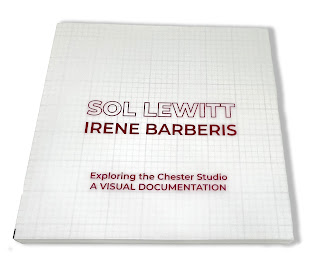IRENE BARBERIS AND THE SOL LEWITT´S CHESTER STUDIO PROJECT
Marcelo Guimarães Lima
SOL LEWITT, IRENE BARBERIS: EXPLORING THE CHESTER STUDIO
A VISUAL DOCUMENTATION
Metasenta Publications, Melbourne
ISBN: 978-0-9941928-1-3
Published: 2022
Authors: Irene Barberis, Lucy R. Lippard, Janet Passehl
Designer: Irene Barberis, Gina Lee (What Gina Did Next)
The studio is the place where physical and mental spaces can coincide for the artist. Actions and objects, processes and products, reality and representation can form intricate networks of flowing energy fluxes coming from the different poles of mind and matter. Fluxes that coalesce momentarily into meaningful singularities, summing up past stages of material and ideal transformative processes and pointing out to future paths and possibilities.
In the studio, perception becomes conception, and concepts materialize into objects of the senses, that is, sensible objects disclosing an intimate rationality at the core of our material being and experience. In the work of art, rationality, the disclosed evidence of necessity as such, and materiality, the - at the same time - familiar, intimate and rather refractory, opaque surfaces of the real, are brought together into relations of mutual affinities, tensions and reinforcements.
In this singular book and art project, artist Irene Barberis brings her artistic energies to revitalize a space of production, the Chester Studio of Sol Lewitt (Chester, Connecticut, USA), closed when the artist passed away in 2007 and kept mostly intact celebrating the man and his art.
In Irene Barberis Chester Studio Project, the studio is also a space of affection, where artistic relations can not be set-apart from human relations in the immediacy of a friendship remembered and re-actualized in art and life. The young Australian artist met the established American artist in New York in the 1970s. This was the beginning of a lifelong friendship and artistic exchanges across time and the continents.
It is interesting that the book opens with the photographic record of Lewitt´s Chester studio, its material, perceptual and conceptual - imaginative environment. Formally, Irene Barberis photographic presentation is related to the book “Autobiography” that Sol Lewitt published in 1980, an inventory in images of lived spaces with their contained objects as a kind of “autobiography” not simply of the photographer, but of these very objects and environments, where the figure of the artist himself is never portrayed, and yet permeates the images, infuses objects and spaces with a kind of aura that discloses a gaze, records an emotional geography of place. The accumulation of images within the rhythmic elements proper of the book as a form, the temporal succession of pages, is counterbalanced by the spatial stability of the grid layout as windows relating inner and outer spaces of perception and memory. The artist's gaze reflected in the world absorbs visible reality and makes it the record of a presence both time bound and timeless.
This emotional geography of place is also the starting point for Irene Barberis series of works made in Lewitt´s studio. They celebrate artistic creativity as essentially a communal act, born of exchanges within communicative spaces of meaning, memory and expression. In her series “Residues”, latex impressions of dusty surfaces recall archaeological methods of preserving layers of time recorded in matter within a given terrain, selected and excavated for its potential as a place where meaningful information on structural processes of transformations, natural and human, can be disclosed. Archaeological sites must be excavated in order to reveal hidden layers of information, that is, they must be disturbed or even destroyed in the very process of revealing and preserving their meanings.
In a similar vein, Irene Barberis revitalization of Sol Lewitt studio adds new layers to the place, to Sol Lewitt´s artistic heritage, reinvigorates and remakes in personal ways aesthetic choices and artistic directions, opening up new vistas both on Lewitt´s and on our own artistic context.
As with different domains of human creativity and spiritual life, art also lives off tradition, that is, by way of handed down ideas and practices developed and preserved for their given values for different generations that build on past accomplishments and meanings. Tradition can be a dynamic spiritual force as long as it is capable of enrichment and transformations. In her paintings, objects and installations, Irene Barberis discloses her own “personal tradition” made of her years as a ballet student and practitioner and musical education, and the formative, if we can so characterize, contact with Sol Lewitt´s art.
The energies of rhythms and colors in her works refashions in original ways the systemic and formal-conceptual elements of Lewitt´s method into pulsating and flowing visual forms and ideas. As Lewitt once stated, method and intuition come together in the artwork. In the case of Irene Barberis, that dynamic synthesis is presented in works that are always, in different ways, of vivid sensual expression in their inner and outer realities. These are works that intend to reward with the same intensity our intellectual perception and our sensory experience, our experience of ourselves as, in the apt formulation of Merleau-Ponty, “embodied minds”.
The present book and artworks are the first part of a larger project of international reach that will include exhibitions, new art projects and presentations in different places and regions around the globe, in accordance with the artist's life experiences, career, and personal vocation towards cultural exchanges and intercultural artistic dialogues.



Comments
Post a Comment